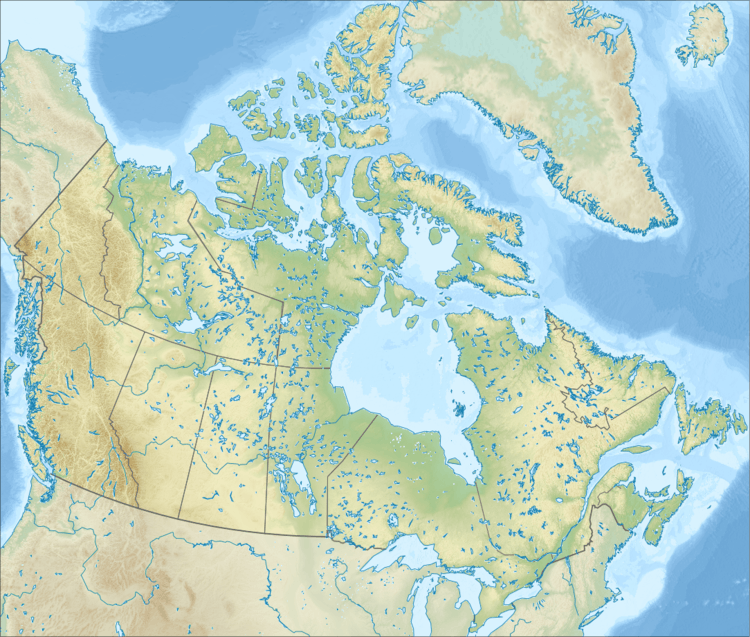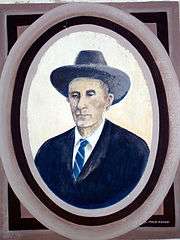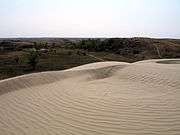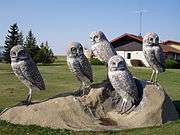Leader, Saskatchewan
| Town of Leader | |
|---|---|
| Town | |
|
Leader welcome sign | |
 Town of Leader  Town of Leader Location of Leader in Saskatchewan | |
| Coordinates: 50°53′N 109°32′W / 50.89°N 109.54°WCoordinates: 50°53′N 109°32′W / 50.89°N 109.54°W | |
| Country | Canada |
| Province | Saskatchewan |
| Region | Saskatchewan |
| Census division | No. 8 |
| Rural Municipality | No. 231 |
| Settled | 1907 |
| Incorporated (village) | 1913 (as Prussia) |
| Incorporated (town) | 1917 (as Leader) |
| Government | |
| • Mayor | Craig Tondevold |
| • Town Administrator | Rochelle Francis |
| Area | |
| • Total | 1.70 km2 (0.66 sq mi) |
| Population (2006) | |
| • Total | 881 |
| • Density | 519.2/km2 (1,345/sq mi) |
| Time zone | CST |
| Postal code | S0N 1H0 |
| Area code(s) | 306 |
| Waterways | South Saskatchewan River |
| Website | Town of Leader |
Leader is a town in southwestern Saskatchewan, Canada, located approximately 350 kilometres (220 mi) directly east of Calgary, Alberta and is near the border between Saskatchewan and Alberta. It has a population of 881 as of 2006.
History

Before settlement, the Leader area was a hunting ground of prehistoric humans. A Midland Folsom point was discovered that the University of Saskatchewan dated back 8,000 to 9,000 years before present.[1]
Leader lies in the traditional territory of the Nekaneet First Nation, who were signatories to Treaty 4.[2]
Homesteaders began arriving in large numbers in 1907; most were German immigrants from southern Russia.[3] An RCMP detachment opened in 1909, and ensured all the settlers had adequate supplies to last the winter. By 1911, the Canadian Pacific Railway purchased a quarter section of land as the prospective site for a settlement.[1] The railway arrived in 1913 and the village of Prussia was incorporated in September of that year.[4] By 1917, anti-German sentiment surrounding the events of World War I prompted the community to change its name, as well as its German street names to numbers. The new name was chosen after a contest won by two local girls, Bertha Keller and Muriel Legault. They were inspired by the arrival of the Regina Morning Leader newspaper on the passenger train. The village name was officially changed to Leader on September 27, 1917;[1] soon after, it incorporated as a town on November 1.[4]
W.T. Smith, a local rancher, had the distinction of building North America's largest barn. The Smith Barn was completed in 1914, having taken 100 men five months to complete its construction; the building measured 400 x 128 x 60 feet. Smith died in 1918, and his massive barn was dismantled down to the concrete foundation in 1921. The concrete foundation remains there to this day.[5]
Following World War II the town's population grew, reaching a peak of 1236 in 1966.[4] Since then the town's population has decreased, following Saskatchewan's overall trend of rural flight.[6]
In 1995, American aviator Steve Fossett landed near Leader after taking off from South Korea, becoming the first person to make a solo flight across the Pacific Ocean in a balloon.[7]
In November 2006, the inhabitants of Leader posed nude for a calendar in act of protest against the deteriorating condition of Highway 32, the main link to the city of Swift Current;[8] it attracted the attention of media outlets in Canada and the United States. In the 2008-2009 provincial budget, the Ministry of Highways committed to rebuild Highway 32 between the villages of Shackleton and Prelate.[9] The project was completed in November 2010 at a cost of $44.4 million.[10]
Geography and climate
Leader is located in Saskatchewan's mixed grassland ecoregion.[11] The southern landscape is dominated by flat plains, with rolling hills by the South Saskatchewan River located 10 km north of Leader. The Great Sand Hills, a 1900 square kilometre region of arid plains and sand dunes, lies just southeast of Leader. The town is located at the junction of highways 21 and 32, and is approximately 30 km east of the border with Alberta.
Like much of southwestern Saskatchewan, Leader experiences a semi-arid climate (Köppen climate classification BSk). Winters are long, cold and dry, while summers are short but very warm. Average precipitation is 10 inches (250 mm) of rain per year and 31 inches (790 mm) of snow per annum. Mean temperatures in the area range from a January low of -19 °C to a summer high in July of +26 °C.[1]
The highest temperature ever recorded in Leader was 41.1 °C (106 °F), which occurred on seven occasions; 16 June 1933, 26 July 1933, 17 July 1936, 29 June 1937, 4 July 1937, 23 June 1941, and 5 August 1961. The coldest temperature ever recorded was −47.8 °C (−54 °F) on 16 February 1936.
| Climate data for Leader, 1981–2010 normals, extremes 1924–present | |||||||||||||
|---|---|---|---|---|---|---|---|---|---|---|---|---|---|
| Month | Jan | Feb | Mar | Apr | May | Jun | Jul | Aug | Sep | Oct | Nov | Dec | Year |
| Record high °C (°F) | 15.0 (59) |
17.0 (62.6) |
26.9 (80.4) |
34.4 (93.9) |
38.3 (100.9) |
41.1 (106) |
41.1 (106) |
41.1 (106) |
37.2 (99) |
33.9 (93) |
22.8 (73) |
19.4 (66.9) |
41.1 (106) |
| Average high °C (°F) | −6.5 (20.3) |
−3.3 (26.1) |
4.1 (39.4) |
13.2 (55.8) |
19.3 (66.7) |
23.9 (75) |
26.3 (79.3) |
26.3 (79.3) |
19.3 (66.7) |
12.3 (54.1) |
0.4 (32.7) |
−5.9 (21.4) |
10.8 (51.4) |
| Daily mean °C (°F) | −11.8 (10.8) |
−8.7 (16.3) |
−1.6 (29.1) |
6.0 (42.8) |
12.1 (53.8) |
16.7 (62.1) |
18.8 (65.8) |
18.5 (65.3) |
12.1 (53.8) |
5.5 (41.9) |
−4.8 (23.4) |
−11.1 (12) |
4.3 (39.7) |
| Average low °C (°F) | −17.0 (1.4) |
−14.2 (6.4) |
−7.2 (19) |
−1.2 (29.8) |
4.8 (40.6) |
9.5 (49.1) |
11.3 (52.3) |
10.7 (51.3) |
4.8 (40.6) |
−1.2 (29.8) |
−10.0 (14) |
−16.2 (2.8) |
−2.2 (28) |
| Record low °C (°F) | −46.7 (−52.1) |
−47.8 (−54) |
−38.9 (−38) |
−31.7 (−25.1) |
−12.5 (9.5) |
−3.9 (25) |
−1.7 (28.9) |
−2.2 (28) |
−11.7 (10.9) |
−30.0 (−22) |
−37.5 (−35.5) |
−46.0 (−50.8) |
−47.8 (−54) |
| Average precipitation mm (inches) | 10.7 (0.421) |
9.6 (0.378) |
20.4 (0.803) |
22.8 (0.898) |
52.1 (2.051) |
58.0 (2.283) |
55.1 (2.169) |
43.6 (1.717) |
32.5 (1.28) |
18.8 (0.74) |
18.3 (0.72) |
16.4 (0.646) |
358.3 (14.106) |
| Average rainfall mm (inches) | 0.0 (0) |
0.3 (0.012) |
4.8 (0.189) |
17.2 (0.677) |
50.3 (1.98) |
58.0 (2.283) |
55.1 (2.169) |
43.6 (1.717) |
30.3 (1.193) |
11.3 (0.445) |
2.1 (0.083) |
0.8 (0.031) |
273.8 (10.78) |
| Average snowfall cm (inches) | 10.6 (4.17) |
9.3 (3.66) |
15.6 (6.14) |
5.6 (2.2) |
1.8 (0.71) |
0.0 (0) |
0.0 (0) |
0.0 (0) |
2.2 (0.87) |
7.6 (2.99) |
16.2 (6.38) |
15.6 (6.14) |
84.5 (33.27) |
| Source: Environment Canada,[12] Extremes 1924–1969,[13] Extremes 1996–present[14] | |||||||||||||
Demographics
| Canada census – Leader, Saskatchewan community profile | |||
|---|---|---|---|
| 2011 | 2006 | 2001 | |
| Population: | 821 (-6.8% from 2006) | 881 (-3.6% from 2001) | 914 (-6.8% from 1996) |
| Land area: | 1.71 km2 (0.66 sq mi) | 1.70 km2 (0.66 sq mi) | 1.70 km2 (0.66 sq mi) |
| Population density: | 481.2/km2 (1,246/sq mi) | 519.2/km2 (1,345/sq mi) | 538.6/km2 (1,395/sq mi) |
| Median age: | 49.2 (M: 48.2, F: 50.1) | 46.1 (M: 45.7, F: 46.6) | 43.6 (M: 42.7, F: 44.4) |
| Total private dwellings: | 425 | 397 | 430 |
| Median household income: | $40,698 | $38,817 | |
| References: 2011[15] 2006[16] 2001[17] | |||
Economy
Including three rural municipalities, Leader, is the center of a retail trading area. The economic base of the community centers around the grain and cattle industries. The major industries in Leader and surrounding area are agricultural services and manufacturing. Leader also has tourism trade from attractions such as the Leader Bird Watching Trail, Smith Barn site, and the Great Sand Hills.[1]
Attractions



Leader is the largest community in close proximity to the Great Sand Hills, a vast area of grassland and sand dunes in southern Saskatchewan. The Great Sand Hills are home to an abundance of wildlife, including sharp-tailed grouse, pronghorn, white pelican, merlin, peregrine falcon, coyote, white-tailed deer, golden eagle, badger, weasel, burrowing owl, mourning dove, porcupine, sandhill crane and fox. It is the only known Saskatchewan habitat of the rare Ord's Kangaroo Rat.[18] Several large sculptures of local wildlife are found at various locations around the town of Leader.[19]
The Great Sand Hills Museum is in the nearby village of Sceptre. The museum features historical displays depicting pioneer life such as a boarding house, hospital, livery stable, school, church, and barn as well as vintage farm machinery.[1]
The South Saskatchewan River valley, just north of Leader, is the largest tract of riparian woodlands between the Cypress Hills and the northern forests. The Leader Bird Watching Trail is suited for viewing many native bird species, including pileated woodpecker, golden eagle, lark sparrow, yellow-breasted chat, red-headed woodpecker, yellow-green swallow, great blue heron, prairie falcon, ferruginous hawk, long-billed curlew, short-eared owl, loggerhead shrike, and burrowing owl.[5] It is also home to the prairie rattlesnake and one of few known localities of rattlesnakes in Saskatchewan.[20] Checkboard Hill, 6.4 km west of Leader on Highway 741, has a wide view of the river and surrounding landscape.[21]
The Smith Barn Site is a provincial heritage site, located approximately ten kilometres northwest of Leader on private property.[22] Its concrete foundation is the only part of the building that remains. A scale model of the barn is located at the Leader tourist information booth.
The Estuary Hutterite Colony was established in 1958. The colony members have preserved the traditional Hutterite production methods, culture, language, and religion. Guided tours of the colony are available to visitors.
Parks and recreation
- River Ridge Golf Course – 18 hole golf course with club house and pro shop
- Leader Swimming Pool – seasonal outdoor heated pool, built in the 1960s and upgraded in the 1990s. Replaced in 2011.
- Leader Millennium Gardens – designed by a student of the University of Guelph School of Landscape Architecture, and built in 2000 in recognition of Leader's history and cultural heritage
- Leader Lions Park – green space with playground structure
- Leader Ball Park – baseball facility with four ball diamonds, grandstands, a concession, beer gardens, and serviced camp sites for visiting teams
- Leader Arena – indoor artificial ice surface for hockey and ice skating
- Leader Curling Rink – curling facility with three artificial ice surfaces
- Leader Community Hall – community hall built in 1983; hosts social events such as weddings and dances
- Leader Friendship Centre – social gathering place for senior citizens[5][23]
Sports
Local sports teams include the Leader Expos (baseball) and the Leader Flyers (hockey). Other sports organizations include the Leader Minor Ball Club, Leader Minor Hockey Club and the Leader Skating Club.
Government
Leader's local government consists of a town council, composed of an elected mayor and six councillors. The current mayor is Craig Tondevold.[24]
In provincial politics, Leader is in the constituency of Cypress Hills. It is currently represented by Wayne Elhard of the Saskatchewan Party, first elected to the Legislature in a by-election in June 1999. He was re-elected in the 1999 provincial election, and again in 2003 and 2007. He is also the current Minister of Highways and Infrastructure.[25]
Leader exists within the federal riding of Cypress Hills—Grasslands. It is currently represented by David L. Anderson of the Conservative Party of Canada, first elected in 2000 and re-elected in 2003 and 2006.[26]
Infrastructure
Transportation
Leader is located at the junction of highways 21 and 32. The former Canadian Pacific Railway line also runs through the town; it is currently operated by the Great Sandhills Railway[27] Leader has an airport with an asphalt runway.
Utilities
Electricity is provided by SaskPower and natural gas is provided by SaskEnergy. The town maintains its own water supply system, including a pump house and filtration plant. Telephone and internet service is provided by SaskTel.
Health care
- Leader Medical Clinic
- Leader Hospital
- Western Seniors' Home
- Leader Home Care Office
- Leader Pharmacy
- Stueck Pharmacy
Public safety
- Cypress Health Region emergency medical services
- Leader & District Fire Department
- RCMP Leader Detachment
Education
- Leader Composite School – teaches students from kindergarten through grade 12[28]
- Great Plains College – offers courses by satellite
- St. Angela's Academy (closed) – independent Catholic residential school for girls in the neighbouring community of Prelate. Closed on June 30, 2007 after 88 years of operation.[29]
See also
References
- 1 2 3 4 5 6 "Community Profiles – Leader" (PDF). Southwest Regional Economic Development Authority. Retrieved 2008-04-04.
- ↑ https://www.aadnc-aandc.gc.ca/DAM/DAM-INTER-SK/STAGING/texte-text/fnl_1100100020617_eng.pdf
- ↑ Barry, Bill (2001). Ukrainian People Places. Regina, Saskatchewan: People Places Publishing Ltd. ISBN 1-894022-65-3.
- 1 2 3 McLennan, David (2006). "Leader". Encyclopedia of Saskatchewan. Retrieved 2008-04-04.
- 1 2 3 "Places to Go". Town of Leader. Retrieved 2010-11-01.
- ↑ Anderson, Alan (2006). "Population Trends". Encyclopedia of Saskatchewan. Retrieved 2008-04-04.
- ↑ "Aviation Adventurer Steve Fossett Missing". CBS News. 2007-09-04. Retrieved 2008-04-04.
- ↑ Cowan, Pamela (2006-11-29). "Nude calendar exposes road neglect". Regina Leader-Post. Retrieved 2008-04-04.
- ↑ Aasa, Marshall (2008). "Highway 32's upgrades in budget". Prairie Post. Retrieved 2008-04-06.
- ↑ "Nude calendar stunt helps pave Sask. highway". CBC News. November 6, 2010. Retrieved 2010-11-06.
- ↑ Secoy, Diane; Canadian Plains Research Center Mapping Division (2006). "Ecozones and Ecoregions" (PDF). Encyclopedia of Saskatchewan. Retrieved 2008-04-05. Cite uses deprecated parameter
|coauthors=(help) - ↑ "Leader 2". Canadian Climate Normals. Environment Canada. Retrieved 21 April 2016.
- ↑ "Leader". Canadian Climate Data. Environment Canada. Retrieved 21 April 2016.
- ↑ "Leader Airport". Canadian Climate Data. Environment Canada. Retrieved 21 April 2016.
- ↑ "2011 Community Profiles". Canada 2011 Census. Statistics Canada. July 5, 2013. Retrieved 2012-08-04.
- ↑ "2006 Community Profiles". Canada 2006 Census. Statistics Canada. March 30, 2011. Retrieved 2009-02-24.
- ↑ "2001 Community Profiles". Canada 2001 Census. Statistics Canada. February 17, 2012. Retrieved 2011-08-01.
- ↑ Yanko, Dave. "Sand, Wind and Time". Virtual Saskatchewan. Retrieved 2008-04-05.
- ↑ "Leader Wildlife Sculptures". Town of Leader. Retrieved 2008-04-06.
- ↑ "Prairie Rattlesnake". Royal Saskatchewan Museum. Retrieved 2009-06-29.
- ↑ "Places to Go". Town of Leader. Retrieved 2011-06-03.
- ↑ "Heritage Property Details – Smith Barn Site" (PDF). Saskatchewan Ministry of Tourism, Parks, Culture and Sport. Retrieved 2008-05-01.
- ↑ "Things to Do". Town of Leader. Retrieved 2010-11-01.
- ↑ "Leader Town Council & Staff". Town of Leader. Retrieved 2010-11-01.
- ↑ "Honourable Wayne Elhard". Government of Saskatchewan. Archived from the original on 2008-04-09. Retrieved 2008-04-05.
- ↑ "PARLINFO – Parliamentarian File – ANDERSON, David L.". Library of Parliament. Retrieved 2008-04-05.
- ↑ "Great Sandhills Railway Ltd. to acquire Empress Shortline". Great Sandhills Terminal Ltd. 2008-07-16. Retrieved 2009-03-31.
- ↑ "Leader and Area Schools". Town of Leader. Retrieved 2008-04-04.
- ↑ Yaworski, Kiply Lukan. "Ursulines will close St. Angela's Academy in Prelate in June 2007" (PDF). Retrieved 2008-04-04.
External links
| Wikimedia Commons has media related to Leader, Saskatchewan. |
- Official website
- Leader entry in the Encyclopedia of Saskatchewan
- Southwest Regional Economic Development Authority
- The Badger - weekly newspaper
 |
Mantario | Eatonia | Eston |  |
| Estuary | |
Prelate | ||
| ||||
| | ||||
| Mendham | Liebenthal |
